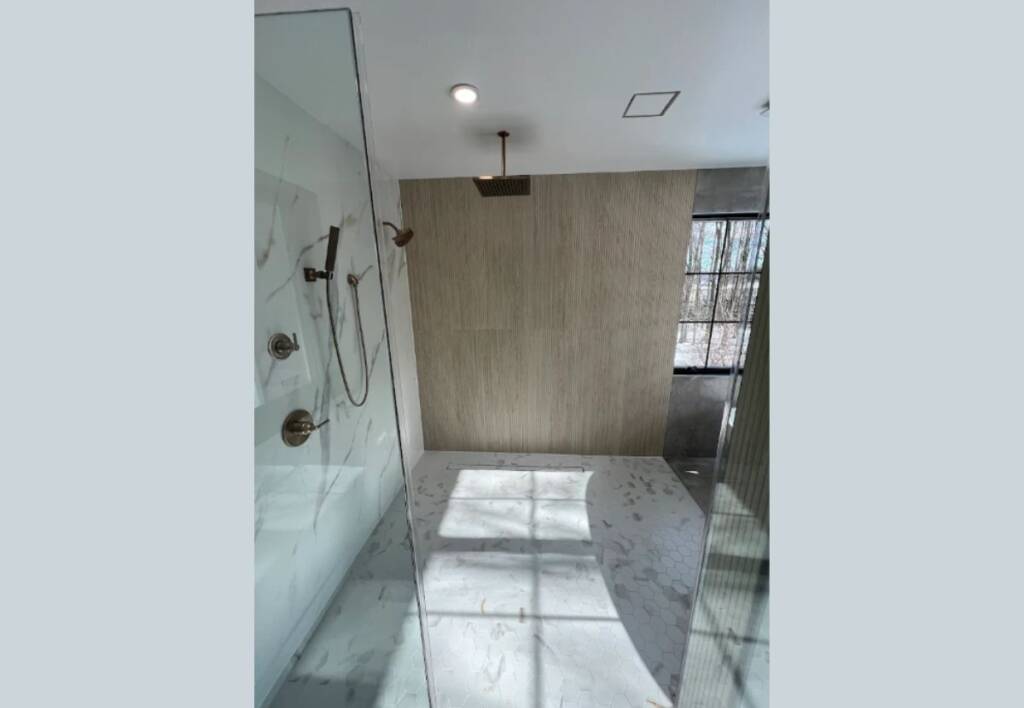The bathroom tile installation cost is one of the first questions people ask, and it should be. Because it’s not just about how the bathroom looks it’s about budget, longevity, mold control, and not ripping things out a second time because it was done wrong the first time.

So, What’s the Price?
In New Jersey, I’m talking about a typical residential job, not a penthouse in Hoboken you’re looking at anywhere from $8 to $20 per square foot for labor alone. That’s just the install. Materials are separate, and they can swing wildly depending on what you pick. Some basic ceramic tiles go for $1.50–$3 per square foot. But porcelain? Natural stone? Mosaic? You can hit $15–$30+ per square foot easily. So it adds up fast.
Let’s do simple math. The average bathroom floor is 40 square feet. Mid-range porcelain tile ($6/sq ft), plus install ($12/sq ft). You’re looking at:
- Tile materials: $240
- Labor: $480
- Total: ~$720 (just for the floor, not walls or shower)
Want to tile the shower walls too? Now you’re talking about another 80–100 sq ft in most cases. It’s not just a small job. And if you’ve got a niche, a bench, some fancy pattern? That number goes up.
Why Does Tile Installation Cost Matter?
Because good tile work isn’t cheap. And cheap tile work isn’t good. Simple as that. A lot of people want to save money and go with the lowest bid, but here’s the thing: bad tile work fails fast. We’re talking about moisture problems, cracked grout, uneven surfaces, or the whole wall sounding hollow when you tap on it. That’s not bonding properly. Or maybe they skipped waterproofing.
And then what? You’re redoing it in two years instead of 15. You didn’t save anything, you spent double.
When’s the Right Time to Tile?
You tile after the plumbing and electrical are done and inspected. Always. No shortcuts. The surface needs to be prepared properly with a cement board or a proper waterproofing system like Schluter or Wedi before anything goes on the wall. If you’re just tiling over a greenboard or drywall in a wet area, forget it. It’s going to fail.
We always check for flatness and pitch. If the floor isn’t sloped right in the shower, water won’t drain properly. That’s a redo waiting to happen. And if the substrate isn’t flat? The tile won’t sit right. That’s how you get lippage where the edge of one tile is sticking up past the one next to it. It looks bad and feels worse.
What Are the Common Mistakes?
There are a few that come up constantly:
- Not using the right waterproofing: RedGard slapped on too thin, or skipped entirely. That’s a mold trap.
- Bad layout: If the tile ends with a tiny sliver at the edge or the niche doesn’t line up, that’s poor planning. You notice that stuff forever.
- Using mastic in wet areas: No. Just no. You need thinset.
- Wrong grout choice: Sanded vs unsanded matters. Epoxy grout is great, but it’s a pain to work with.
- DIY tile levelling systems misused: Those clip systems can help, but only if you know what you’re doing. Otherwise, you just lock in a crooked tile.
I’ve torn out dozens of jobs done by someone’s “handyman cousin” or a rushed crew who didn’t care. Customers think they’re saving money but then they’re calling us two years later to redo it all, plus fix water damage. That’s not a win.
What You’re Paying For
People forget that when you hire a real pro, you’re not just paying someone to stick tiles on a wall. You’re paying for years of experience, knowing what can go wrong, and how to prevent it. You’re paying for the layout to be clean, cuts to be tight, waterproofing to be right, and everything to last. That’s what we do at Precise Tile & Stone. We don’t rush it, and we don’t cut corners.
We take the time to prep the surface, waterproof it, and lay everything out before even touching the thinset. And yeah, that costs more. But it also means your bathroom still looks good in 10–15 years. Not crumbling or growing mushrooms behind the wall.
How to Keep Costs in Check Without Ruining the Job
Now, if you’re on a tighter budget, here’s what I’d tell you:
- Go with a simple layout. Straight lay or brick pattern. No diagonals or complicated mosaics unless you’ve got the budget for it.
- Limit accent tiles to a small section instead of the whole wall.
- Keep the tile size consistent. Large-format tiles cost more to install because they need a flatter surface and more levelling work.
- Do the demo yourself if you’re careful. But only if you understand what’s behind the wall.
- Don’t cheap out on materials that need to last, like waterproofing or grout. Those aren’t the places to save.
Final Thought
Bathroom tile installation is one of those things where price reflects skill. Anyone can stick tiles on a wall. But making it last, making it look clean, making it drain right, that takes experience. That’s what you’re paying for.
And if someone gives you a price that seems too good to be true? It is. Call me after the tiles start falling off. Or skip the headache and do it right the first time.